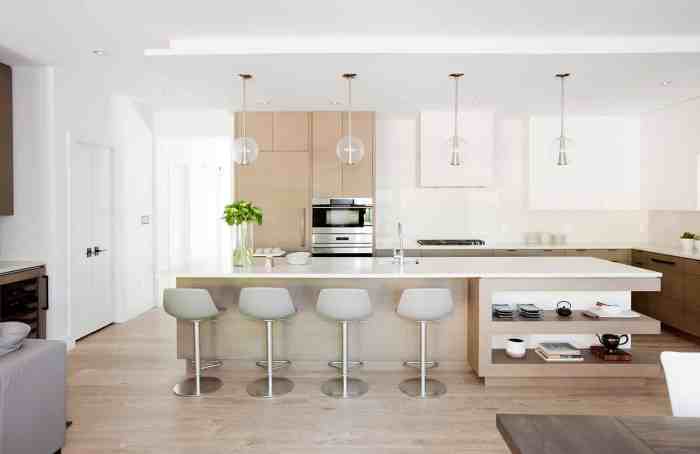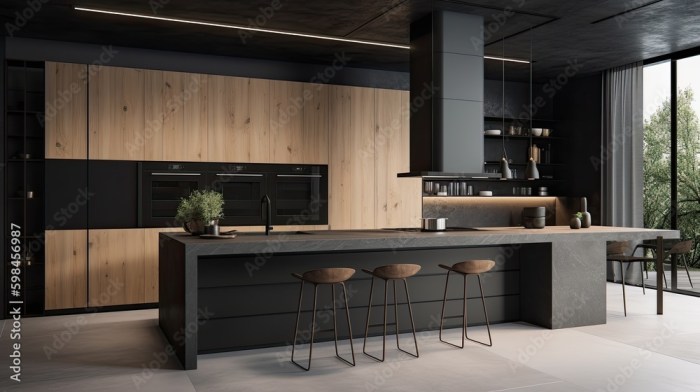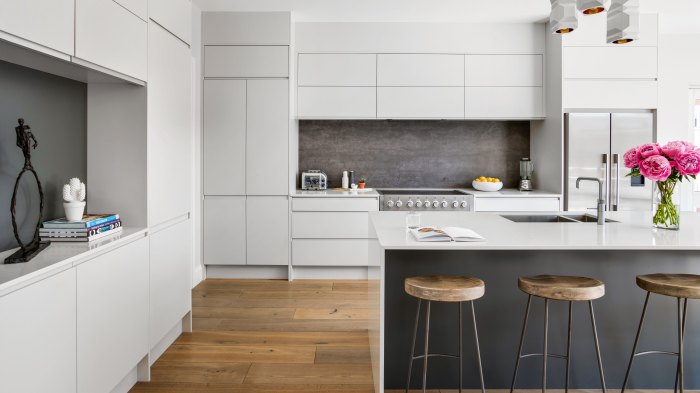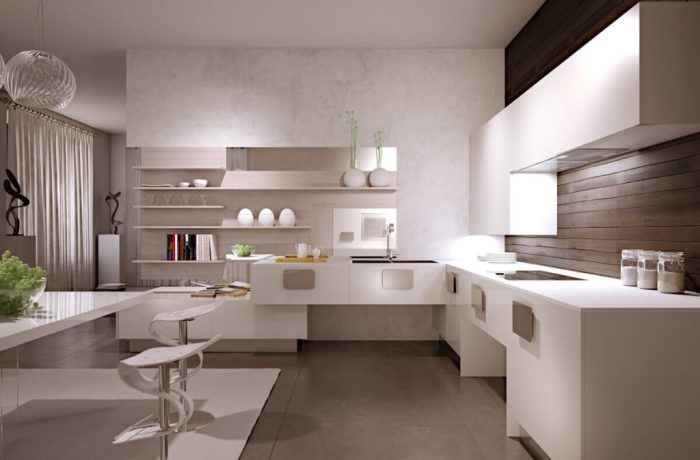The minimalist kitchen, a sanctuary of streamlined elegance, finds its soul in the concept of “clean lines.” This isn’t merely an aesthetic choice; it’s a design principle deeply rooted in psychological impact, influencing our perception of space, order, and tranquility. The absence of visual clutter, achieved through carefully selected materials, cabinetry, and appliance integration, creates an environment that promotes calm and focus.
This exploration delves into the science behind this design philosophy, examining how clean lines translate into a functional and aesthetically pleasing kitchen space.
We’ll investigate the interplay of materials – from the cool neutrality of stainless steel to the warm embrace of natural wood – and how their textures and finishes contribute to the overall effect. Cabinetry design, a critical element in achieving clean lines, will be analyzed, including the advantages and disadvantages of handleless designs and open shelving. Furthermore, we’ll explore the role of lighting and backsplash choices in enhancing or detracting from this minimalist aesthetic, culminating in detailed examples of kitchens that masterfully embody the concept of clean lines.
Defining “Clean Lines” in Minimalist Kitchen Design

Minimalist kitchen design prioritizes simplicity and functionality, and a key element achieving this aesthetic is the strategic use of clean lines. These lines, far from being merely visual, contribute significantly to the overall feeling of space, order, and tranquility within the kitchen environment. Understanding their characteristics and impact is crucial to appreciating the core principles of minimalist design.Clean lines in minimalist kitchens are characterized by their uncluttered, straightforward nature.
They are characterized by the absence of ornamentation, avoiding curves or excessive detailing. Instead, the focus is on sharp, precise edges and smooth, uninterrupted surfaces. This is achieved through the selection of furniture with simple geometric forms, the use of handleless cabinetry, and the integration of sleek appliances. Imagine a kitchen with floor-to-ceiling cabinets featuring flush-mounted doors, devoid of any decorative moldings or embellishments.
The countertops extend seamlessly, meeting the backsplash in a continuous plane, further reinforcing the sense of linearity. The overall effect is one of visual harmony and understated elegance.
Visual Characteristics of Clean Lines in Minimalist Kitchens
The visual impact of clean lines is predicated on their ability to create a sense of spaciousness and order. In contrast to traditional kitchens, which often feature ornate details, curved lines, and a multitude of textures, minimalist kitchens prioritize a streamlined aesthetic. Farmhouse kitchens, for instance, typically incorporate rustic elements like exposed beams and distressed wood, resulting in a more textured and visually busy appearance.
Clean lines, in contrast, offer a sense of visual calm, guiding the eye effortlessly across the space. This contrasts sharply with the more fragmented and potentially overwhelming visual experience of a traditional or farmhouse kitchen, where the eye might be drawn to various competing elements.
Psychological Impact of Clean Lines in Kitchen Environments
The psychological impact of clean lines in a kitchen environment is significant. Studies in environmental psychology have shown a correlation between clean, uncluttered spaces and reduced stress levels. The absence of visual clutter, a hallmark of clean lines, allows for a more focused and relaxed experience. The sense of order and simplicity inherent in clean-line design fosters a feeling of calm and control, creating a more conducive environment for both cooking and socializing.
This is in stark contrast to kitchens filled with visually busy elements, which can be perceived as overwhelming and potentially stressful. The clean lines create a sense of visual breathing room, contributing to a more peaceful and efficient workspace.
Material Choices and Clean Lines

The pursuit of clean lines in minimalist kitchen design hinges significantly on the judicious selection of materials. The inherent properties of each material—its texture, color, and the way it reflects light—directly impact the overall visual effect, either reinforcing or disrupting the intended aesthetic. Understanding these material properties is crucial for achieving a harmonious and uncluttered space.The interplay between material and form is paramount.
A poorly chosen material can visually break up clean lines, creating a sense of visual noise that contradicts the minimalist ethos. Conversely, the right material can subtly enhance the lines, adding depth and visual interest without sacrificing the desired simplicity.
Material Selection for a Minimalist Kitchen
The following table illustrates how different materials contribute to a minimalist kitchen design emphasizing clean lines. The visual impact is subjective, varying based on individual preferences and lighting conditions, but general trends are observable.
| Material | Application | Visual Impact | Scientific Rationale |
|---|---|---|---|
| Light Oak Wood | Cabinets, shelving | Warm, natural, enhances clean lines with its smooth grain. | The relatively uniform grain of light oak provides a visually consistent surface, minimizing interruptions to clean lines. Its light color reflects light evenly, further enhancing the perception of clean, uncluttered space. |
| Calacatta Marble | Countertops, backsplash | Luxurious, elegant, clean lines are emphasized by its veining patterns (depending on the specific slab). | The veining in Calacatta marble, while adding visual interest, can sometimes disrupt perfectly straight lines. Careful selection of slabs with minimal, subtle veining is key. The polished surface enhances light reflection, contributing to a sense of spaciousness. |
| Stainless Steel | Appliances, sink | Modern, sleek, can enhance or detract from clean lines depending on the finish. | Brushed stainless steel minimizes reflections and visual distractions, complementing clean lines. However, highly polished stainless steel can create distracting reflections, potentially disrupting the visual flow. |
| Matte Black Porcelain | Countertops, sink | Sophisticated, understated, clean lines are accentuated by the absence of shine. | The matte finish minimizes reflections, allowing the form of the countertop to take center stage. The dark color provides a neutral backdrop, enhancing the visual impact of other elements in the kitchen. |
Impact of Material Finishes on Clean Lines
Stainless steel, as mentioned, presents a prime example of how finish impacts visual perception. A brushed stainless steel finish minimizes reflections, contributing to a sense of visual calm and allowing the clean lines of appliances to dominate. In contrast, a highly polished finish creates significant reflections, potentially disrupting the visual clarity and detracting from the minimalist aesthetic. Similarly, matte finishes on cabinetry or countertops help reduce glare and enhance the perception of clean lines, while glossy finishes can create visual distractions.
The principle at play is the reduction of visual noise; matte finishes absorb more light, leading to less reflection and thus a cleaner, more streamlined appearance.
Color Palettes for Minimalist Kitchens
The choice of color palette significantly impacts the perception of clean lines in a minimalist kitchen. A poorly chosen palette can introduce visual clutter, while a well-chosen one can subtly enhance the sense of order and spaciousness.
Three effective color palettes are:
- Monochromatic White and Gray: This palette uses variations of white and gray to create a calming, spacious feel. The lack of strong color contrasts keeps the focus on the clean lines of the architecture and the chosen materials. This scheme is scientifically supported by studies demonstrating the relaxing effects of neutral color schemes on the human visual system.
- Warm Neutrals (Beige, Cream, Light Wood Tones): This palette uses warmer neutrals to create a more inviting and less stark atmosphere. The subtle variations in tone maintain a sense of visual unity, while the warmth adds a human touch to the otherwise minimalist design. The use of light wood tones adds texture without sacrificing visual cleanliness.
- Black and White with Natural Wood Accents: This palette offers a striking contrast between the starkness of black and white and the warmth of natural wood. The strategic use of wood accents breaks up the potentially harsh contrast while maintaining the overall minimalist feel. This high-contrast scheme creates visual interest without overwhelming the space, allowing the clean lines to remain the focal point.
Cabinetry and Storage Solutions for Clean Lines
The pursuit of clean lines in minimalist kitchen design necessitates a strategic approach to cabinetry and storage. Effective storage solutions are not merely functional; they are integral to maintaining the visual purity and uncluttered aesthetic that defines this style. The careful selection of materials, hardware, and design elements directly impacts the overall impression of space and order.
Minimalist kitchen cabinetry prioritizes seamless integration and a lack of visual clutter. This is achieved through a variety of techniques, each contributing to the overall effect of clean, unblemished surfaces.
Handleless Cabinetry and Recessed Hardware
Handleless cabinet designs eliminate the visual disruption caused by traditional knobs and pulls. This sleek, integrated look enhances the sense of spaciousness and contributes to the minimalist aesthetic. The absence of protruding hardware creates a smooth, uninterrupted surface, allowing the eye to flow effortlessly across the cabinetry. Recessed handles, subtly integrated into the cabinet doors, offer a similar effect, providing functionality without compromising the clean lines.
Examples of handleless mechanisms include push-to-open systems, where a gentle press opens the door, and touch-sensitive mechanisms, offering a futuristic and seamless experience. These systems often rely on precision engineering and high-quality materials to ensure durability and reliable operation, often using gas springs or dampers for smooth, quiet closing.
Open Shelving Versus Closed Cabinetry
The choice between open shelving and closed cabinetry significantly impacts the overall visual impression of a minimalist kitchen. Open shelving offers a sense of airiness and openness, displaying carefully curated items as part of the design. However, it requires meticulous organization and a commitment to maintaining a clutter-free display to avoid detracting from the minimalist aesthetic. Closed cabinetry, conversely, conceals storage, maintaining a clean, uncluttered appearance regardless of the contents.
This approach prioritizes functionality and order, ideal for those who prefer a more streamlined look and prioritize hidden storage. The effective use of both open and closed storage can create a balanced approach, showcasing selected items while keeping the majority of kitchenware neatly tucked away. For instance, a few open shelves could display favorite cookbooks or decorative bowls, while closed cabinets store everyday dishes and appliances.
Innovative Storage Solutions for Clutter-Free Kitchens
Effective storage is paramount in maintaining a minimalist kitchen’s clean lines and uncluttered feel. A well-organized space is essential for achieving the desired aesthetic.
The following innovative storage solutions contribute significantly to a clutter-free and visually clean minimalist kitchen:
- Pull-out pantry systems: These maximize vertical space and allow for easy access to all stored items, eliminating the need to rummage through deep cabinets.
- Slim-line drawers: Designed to fit narrow spaces, these drawers optimize storage in areas that might otherwise be wasted.
- Corner cabinet organizers: These utilize often-underutilized corner space, transforming awkward areas into efficient storage zones.
- Vertical utensil organizers: These space-saving solutions keep utensils neatly organized and easily accessible within drawers.
- Built-in spice racks: These sleek, integrated racks maintain a clean aesthetic while providing easy access to spices.
Appliances and Fixtures

Maintaining clean lines in a minimalist kitchen necessitates a meticulous approach to appliance and fixture selection and integration. The visual impact of these elements significantly influences the overall aesthetic, demanding careful consideration of form, function, and their relationship to the broader design scheme. A successful integration ensures these essential components enhance, rather than detract from, the clean lines and uncluttered feel of the space.Appliance Selection for Clean LinesThe selection of appliances should prioritize streamlined designs with minimal ornamentation.
Panel-ready appliances, designed to be concealed behind custom cabinetry, offer the most seamless integration. Their flush surfaces maintain the unbroken lines of the cabinetry, creating a unified and uncluttered look. Freestanding appliances, if used, should be chosen for their sleek, simple profiles and neutral color palettes. Stainless steel, while popular, can sometimes clash with a minimalist aesthetic; consider matte black or white finishes for a more cohesive look.
The dimensions of the appliances should also be carefully considered to ensure a balanced and proportional arrangement within the kitchen’s layout. Oversized or awkwardly proportioned appliances can disrupt the clean lines and visual harmony of the space.
Minimalist Kitchen Layout with Integrated Appliances
A minimalist kitchen layout emphasizing clean lines might feature a linear arrangement of cabinetry along one wall, incorporating a built-in refrigerator, oven, and microwave seamlessly into the cabinetry. A sleek, built-in induction cooktop, flush with the countertop, avoids the visual disruption of a raised hob. A freestanding dishwasher, chosen for its clean lines and matching finish, could be positioned discreetly beside the cabinetry.
The opposite wall could feature a simple, minimalist island with a waterfall countertop, providing additional counter space and storage. Imagine a kitchen painted in a soft, neutral grey, with white matte cabinetry and a black-stained oak island. The appliances, predominantly built-in and hidden behind the cabinetry’s clean surfaces, maintain the visual flow and unity of the design. The overall effect is one of understated elegance and functional simplicity.
Lighting Fixtures and Clean Lines
Lighting fixtures can significantly contribute to or detract from the clean lines of a minimalist kitchen. Recessed lighting, often preferred for its unobtrusive nature, provides even illumination without disrupting the visual plane of the ceiling. Linear pendant lights, suspended above the island or peninsula, can add a subtle yet stylish element while maintaining the clean lines of the design.
However, overly ornate or excessively large fixtures can disrupt the visual harmony and detract from the overall minimalist aesthetic. Avoid chandeliers or pendant lights with intricate detailing. Instead, opt for simple geometric forms, such as cylindrical or square pendants in matte black or brushed nickel. Under-cabinet lighting, strategically placed to illuminate workspaces, provides functional illumination without cluttering the visible space.
The use of dimmable LED lighting allows for adjustable brightness and ambiance, adding further versatility to the minimalist design.
Illustrative Examples of Clean Lines in Minimalist Kitchens
The pursuit of clean lines in minimalist kitchen design transcends mere aesthetics; it’s a fundamental principle influencing functionality, spatial perception, and the overall sense of calm. This section explores three distinct minimalist kitchen designs, each showcasing the unique expression of clean lines through layout, material selection, and color palettes. We will then delve into a specific example of a large kitchen island, and finally examine the impact of backsplash choices on the overall design.
Three Minimalist Kitchen Design Examples
The following examples illustrate diverse interpretations of clean lines within the minimalist aesthetic. Each design prioritizes simplicity, functionality, and a sense of spaciousness achieved through careful consideration of form and material.
Example 1: The Scandinavian Minimalist Kitchen This design emphasizes natural light and a neutral color palette. Imagine a kitchen with white cabinetry, light oak countertops, and a pale grey backsplash. The layout is linear, with appliances seamlessly integrated into the cabinetry. The absence of excessive ornamentation or decorative elements allows the clean lines of the cabinetry and the natural grain of the wood to stand out.
The overall feeling is one of airy spaciousness and understated elegance. This approach aligns with the principles of Scandinavian design, known for its functionality and use of natural materials.
Example 2: The Industrial Minimalist Kitchen In contrast to the Scandinavian example, this design embraces a more industrial aesthetic. Imagine a kitchen with dark grey or black cabinetry, stainless steel countertops, and exposed brick walls. The clean lines are achieved through the stark geometry of the cabinetry and the industrial materials. Metal accents and visible piping contribute to the industrial feel, while the lack of clutter and ornamentation maintains the minimalist aesthetic.
This design showcases how clean lines can be integrated into a more rugged and textural style.
Example 3: The Japanese Minimalist Kitchen This design embodies simplicity and tranquility. Imagine a kitchen featuring light-colored wood cabinetry, a muted color palette (think greys, beiges, and whites), and minimal hardware. The layout is often characterized by built-in seating and a focus on functionality. Natural materials like bamboo or stone might be incorporated, enhancing the feeling of serenity and connection to nature.
The clean lines here stem from a deliberate restraint, emphasizing functionality and a sense of quiet contemplation.
Minimalist Kitchen with a Large Island
Consider a minimalist kitchen featuring a substantial island measuring approximately 10 feet long by 4 feet wide. The island is constructed from a single slab of polished concrete, its smooth surface reflecting light and enhancing the feeling of spaciousness. The clean lines of the rectangular island are further emphasized by the lack of decorative elements. The island incorporates a built-in sink, a cooktop, and ample storage space within the lower cabinets.
The concrete’s inherent texture provides a subtle visual interest, while maintaining the overall minimalist aesthetic. The choice of concrete offers durability and a modern, industrial feel, complementing a variety of cabinetry and backsplash options. The island’s substantial size allows for both food preparation and informal dining, optimizing kitchen functionality.
Backsplash Options and Clean Lines
The backsplash plays a crucial role in maintaining or disrupting the clean lines of a minimalist kitchen.
Solid Color Backsplash: A solid-color backsplash, such as a matte white or a muted grey, enhances the perception of clean lines by creating a visually uninterrupted surface. The lack of pattern or texture allows the focus to remain on the cabinetry and other architectural features, maintaining a sense of simplicity and order. This is a classic choice for minimalist kitchens, ensuring visual harmony and minimizing visual distractions.
Subtle Pattern Backsplash: A backsplash with a very subtle pattern, such as a barely-there linear pattern or a finely textured tile, can add a touch of visual interest without compromising the clean lines of the design. The key is to choose a pattern that is understated and doesn’t compete with the overall minimalist aesthetic. For example, a backsplash with very thin, horizontal lines could subtly echo the horizontal lines of the cabinetry, creating a sense of visual cohesion.
The pattern should be minimal enough to be almost imperceptible from a distance, enhancing the overall feeling of simplicity.
Summary

Ultimately, the pursuit of clean lines in a minimalist kitchen is not about stripping away elements, but about carefully curating them. It’s a delicate balance between functionality and aesthetics, where every material, every fixture, and every line contributes to a cohesive and calming atmosphere. By understanding the principles of clean-line design – from material selection to appliance integration – we can create kitchens that are not only visually stunning but also promote a sense of peace and order, transforming the heart of the home into a haven of serenity.
FAQ Overview
What are the downsides of a minimalist kitchen?
Minimalist kitchens, while aesthetically pleasing, can sometimes lack storage space if not carefully planned. They may also feel cold or impersonal if natural materials and warmer color palettes aren’t incorporated thoughtfully.
How can I maintain a clean-lined aesthetic with children?
Choose durable, easy-to-clean materials. Utilize closed cabinetry and smart storage solutions to minimize visible clutter. Consider incorporating child-safe features without compromising the overall design.
Are minimalist kitchens expensive?
The cost can vary greatly depending on material choices and custom design elements. While high-end materials can increase the expense, smart planning and the use of more affordable, yet stylish options can create a beautiful minimalist kitchen on a budget.
Can I achieve clean lines on a small budget?
Absolutely. Focus on repainting existing cabinets in a neutral color, updating hardware, and incorporating affordable yet stylish elements like open shelving and simple lighting fixtures. Strategic use of mirrors can also enhance the sense of space.
How do I incorporate color in a clean-lined minimalist kitchen?
Use a neutral base (white, gray, beige) and introduce pops of color through accessories, artwork, or a statement backsplash. Avoid using too many colors to maintain the clean and uncluttered aesthetic.